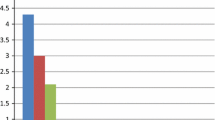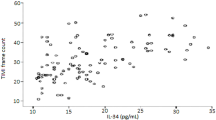Abstract
Introduction
We investigated the probable role of free-radical damage in the pathogenesis of slow coronary flow (SCF) by using oxidative stress parameters.
Methods
Sixty-four patients with angiographically proven SCF and 63 patients with normal coronary flow (NCF) pattern with similar risk profiles were enrolled in this study. We measured erythrocyte superoxide dismutase (SOD), reduced glutathione (GSH), serum malondialdehyde (MDA), catalase and myeloperoxidase (MPO) levels in all subjects.
Results
There were statistically significant differences in the levels of erythrocyte SOD, GSH and serum MDA between the 2 groups. Serum MDA (P=0.003) and erythrocyte SOD levels (P=0.0001) were increased in the SCF group. The level of erythrocyte GSH (P=0.010) was lower in patients with SCF. There were no differences between the groups’ serum catalase (P=0.682) and MPO levels (P=0.070).
Conclusion
Our data showed that in patients with SCF, serum MDA and erythrocyte SOD levels were increased while erythrocyte GSH levels were decreased significantly, compared with NCF patients. These results indicate that free-radical damage may play a role in the pathogenesis of SCF.
Similar content being viewed by others
References
Tambe AA, Demany MA, Zimmerman HA, Mascarenhas E. Angina pectoris and slow flow velocity of dye in coronary arteries, a new angiographic finding. Am Heart J. 1972;84:66–71.
Pekdemir H, Cin VG, Cicek D, et al. Slow coronary flow may be a sign of diffuse atherosclerosis. Contribution of FFR and IVUS. Acta Cardiol. 2004;59:127–133.
Graham IM, Daly LE, Refsum HM, et al. Plasma homocysteine as a risk factor for vascular disease. The European Concerted Action Project. JAMA. 1997;277:1775–1781.
Tawakol A, Omland T, Gerhard M, Wu JT, Creager MA. Hyperhomocyst(e)inemia is associated with impaired endothelium-dependent vasodilation in humans. Circulation. 1997;95:1119–1121.
Goel PK, Gupta SK, Agarwal A, Kapoor A. Slow coronary flow: a distinct angiographie subgroup in syndrome X. Angiology. 2001;52:507–514.
Beltrame JF, Turner SP, Horowitz JD. Persistence of the coronary slow flow phenomenon. Am J Cardiol. 2001;88:938.
Mosseri M, Yarom R, Gotsman MS, Hasin Y. Histologic evidence for small vessel coronary artery disease in patients with angina pectoris and patent large coronary arteries. Circulation. 1986;74:964–972.
Kurtoglu N, Akcay A, Dindar I. Usefulness of oral dipyridamole therapy for angiographic slow coronary artery flow. Am J Cardiol. 2001;87:777–779.
Vrints C, Herman AG. Role of the endothelium in the regulation of coronary artery tone. Acta Cardiol. 1991;46:399–418.
Stocker R, Keaney JF. Role of oxidative modifications in atherosclerosis. Physiol Rev. 2004;84:1381–1478.
Li JJ, Xu B, Li ZC, Qian J, Wei BQ. Is slow coronary flow associated with inflammation? Med Hypothesis. 2006;66:504–508.
Turhan H, Saydam GS, Erbay AR, et al. Increased plasma soluble adhesion molecules; ICAM-1, VCAM-1, and E-selectin levels in patients with slow coronary flow. Int J Cardiol. 2006;108:224–230.
Devasagayam TP, Tilak JC, Boloor KK, Sane KS, Ghaskadbi SS, Lele RD. Free radicals and antioxidants in human health: current status and future prospects. J Assoc Phys India. 2004;52:794–804.
Eugene AP, Husam M, Stanley LH. Myeloperoxidase-generated oxidants and atherosclerosis. Free Radic Biol Med. 2000;28:1717–1725.
Hurst JK. Myeloperoxidase-active site structure and catalytic machanisms. In: Everse J, Everse K, Grisham MB, eds. Peroxidases in Chemistry and Biology. Boca Raton: CRC Press; 1991:37–62.
Kettle AJ, Winterbourn CC. Myeloperoxidase: a key regulator of neutrophil oxidant production. Redox Rep. 1997;3:3–15.
Hazen SL, Hsu FF, Mueller DM, Crowley JR, Heinecke JW. Human neutrophils employ chlorine gas as an oxidant during phagocytosis. J Clin Invest. 1996;98:1283–1289.
Weiss SJ, Klein R, Slivka A, Wei M. Chlorination of taurine by human neutrophils. Evidence for hypochlorous acid generation. J Clin Invest. 1982;70:598–607.
Schwenke DC. Antioxidants and atherogenesis. J Nutr Biochem. 1998;9:424–445.
Chen J, Mehta JL. Role of oxidative stress in coronary heart disease. Indian Heart J. 2004;56:163–173.
Kaneda H, Taguchi J, Ogasawara K, Aizawa T, Ohno M. Increased level of advanced oxidation protein products in patients with coronary artery disease. Atherosclerosis. 2002;162:221–225.
Gibson CM, Cannon CP, Daley WL, et al. TIMI frame count: a quantitative method of assessing coronary artery flow. Circulation. 1996;93:879–888.
Ohkawa H, Ohishi N, Yagi K. Assay for lipid peroxides in animal tissues by thiobarbituric acid reaction. Anal Biochem. 1979;95:351–358.
Winterbourn CC, Hawkings RE, Brian M, Carrel RW. The estimation of red cells superoxide dismutase activity. J Lab Clin Med. 1975;85:337–342.
Moron MS, Depierre JW, Mannervik B. Level of glutathione, glutathione reductase and glutathione-S-transferase activity in rat lung and liver. Biochem Biophys Acta. 1979;82:67–78.
Knight KR, Zhang B, Morrison WA, Stewart AG. Ischaemia-referfusion injury in mouse skeletal muscle is reduced by N-nitro-L-arginine methyl ester and dexamethasone. Eur J Pharmacol. 1997;332:273–278.
Aebi H. Catalase in vitro. Methods Enzymol. 1984;105:121–126.
Baskol G, Demir H, Baskol M, et al. Assessment of paraoxonase 1 activity and malondialdehyde levels in patients with rheumatoid arthritis. Clin Biochem. 2005;38:951–955.
Akca T, Canbaz H, Tataroglu C, et al. The effect of N-acetylcysteine on pulmonary lipid peroxidation and tissue damage. J Surg Res. 2005;129:38–45.
Yu BP. Cellular defenses against damage from reactive oxygen species. Phys Rev. 1994;74:139–162.
Erol U, Gurdal M, Erol A, Aslan R, Konukoğlu D, Onmus H. Is midazolam effective as an antioxidant in preventing reperfusion injury in rat kidney? Int Urol Nephrol. 2002;34:121–127.
Bhagwat SV, Vijayasarathy C, Raza H, Mullick J, Avadhani NG. Preferential effects of nicotine and 4-(N-methyl-N-nitrosamino)-1-(3-pyridyl)-1-butanone on mitochondrial glutathione S-transferase a4-4 induction and increased oxidative stress in the rat brain. Biochem Pharm. 1998;56:831–839.
Lau D, Baldus S. Myeloperoxidase and its contributory role in inflammatory vascular disease. Pharmacol Ther. 2006;111:16–26.
Author information
Authors and Affiliations
Corresponding author
Rights and permissions
About this article
Cite this article
Enli, Y., Turk, M., Akbay, R. et al. Oxidative stress parameters in patients with slow coronary flow. Adv Therapy 25, 37–44 (2008). https://doi.org/10.1007/s12325-008-0011-4
Published:
Issue Date:
DOI: https://doi.org/10.1007/s12325-008-0011-4




